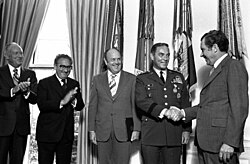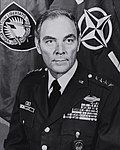Alexander Haig
Alexander Meigs Haig, Jr. (December 2, 1924 – February 20, 2010) was a United States Army general and diplomat.
He was the United States Secretary of State under President Ronald Reagan. He was also White House Chief of Staff under Presidents Richard Nixon and Gerald Ford. He also was Vice Chief of Staff of the Army. This is the second-highest ranking officer in the Army.[1] He was in charge of all US and NATO forces in Europe.
Haig was a veteran of the Korean War and Vietnam War. He received the Distinguished Service Cross, the Silver Star with oak leaf cluster, and the Purple Heart.[2]
On February 20, 2010, Haig died from complications from a staphylococcal infection, aged 85.[3]
Life and career
Haig was born in Pennsylvania and had two siblings. His father died when he was young and he was raised by his mother. Haig went to college at Notre Dame University for two years before switching to the United States Military Academy. He later attended Columbia and Georgetown to get his masters. While in the army, he served in the Korean War in several major battles. He served as a commander in the Vietnam War. At one point, his helicopter was shot down and he saw two days of violent hand-to-hand combat. He was awarded the Purple Heart and Distinguished Flying Cross for his notable bravery in wartime.
In 1969, President Richard Nixon made him a national security advisor. Haig helped negotiate the ceasefire in the Vietnam War. Nixon promoted him to White House Chief of Staff after H. R. Haldeman resigned facing criminal charges. Haig has been praised by many people by keeping the government running during the Watergate scandal that brought down Nixon. Haig has even been called an "acting president" during the last days of Nixon's administration. When Nixon was forced to resign, Haig helped the new president Gerald Ford. He remained Chief of Staff during Ford's administration.
In 1974, Haig became Supreme Allied Commander of Europe, a job that made him the head of all NATO forces. In 1979 he survived an assassination attempt. In 1979, he retired from the army as a four star general. After this he was on the board of a number of companies. In 1981, Ronald Reagan appointed him as Secretary of State. In this new job, Haig was the head of US foreign policy. Haig believed that the US should take a strong stand against the Soviet Union.
In March 1981, Reagan was shot by John Hinckley, Jr., a mentally ill man in Washington DC. Vice President George Bush was on a plane, and Haig was put in charge of the government until Bush could be reached. He told reporters that "I am in control here." Reagan made a full recovery.
In 1982, after Argentina invaded the Falkland Islands, Haig tried to solve the crisis peacefully by bringing UK Prime Minister Margaret Thatcher and Argentinian dictator Leopoldo Galtieri to negotiate. No solution was reached and the crisis ended with the full blown Falklands War between the two countries. The British won the war, and Galtieri's regime collapsed. In July 1982, Haig retired from the State Department. Reagan nominated George Schultz as the new Secretary of State.
Haig ran for President in 1988, but George Bush beat him. Haig was involved in a number of businesses after leaving office. He also advised several presidents, who wanted his expertise in foreign policy. In 2006, President George W. Bush held a meeting of ten former State and Defense Secretaries. Haig was at the meeting. He published his memoirs in 1992.
Haig died of natural causes on February 20, 2010. He is buried in Arlington National Cemetery.
Alexander Haig Media
Major General Haig being presented with the Distinguished Service Medal by President Richard Nixon in the Oval Office in 1973
Henry Kissinger, Richard Nixon, Gerald Ford, and Haig meeting on Ford's forthcoming appointment as vice president in 1973
General Haig during his tenure as Supreme Allied Commander Europe
Haig welcoming Israeli prime minister Menachem Begin at Andrews Air Force Base, 1982
Haig with British prime minister Margaret Thatcher at Andrews Air Force Base, 1982
References
- ↑ "ALEXANDER M. HAIG, Assistant to the President: Files, 1973–74". Archived from the original on November 15, 2011. Retrieved August 14, 2012.
- ↑ Former Secretary of State Alexander Haig dies at 85. Cnn.com. February 20, 2010. http://www.cnn.com/2010/POLITICS/02/20/alexander.haig.dead/index.html. Retrieved December 20, 2012.
- ↑ Haig, top adviser to 3 presidents, hospitalized. February 19, 2010. http://hosted.ap.org/dynamic/stories/U/US_HAIG_HOSPITALIZED?SITE=CALAK&SECTION=HOME&TEMPLATE=DEFAULT. Retrieved February 20, 2010.
Other websites
![]() Media related to Alexander Haig at Wikimedia Commons
Media related to Alexander Haig at Wikimedia Commons
- The Day Reagan was Shot article on Haig
- The Falklands: Failure of a Mission Archived 2004-12-17 at the Wayback Machine critique of Haig's mediation efforts
- Portrait of Alexander Haig Archived 2007-11-17 at the Wayback Machine by Margaret Holland Sargent
- Alexander Haig on IMDb
- Obituary -The Economist.
- Burial site of Alexander Haig -Find A Grave.










